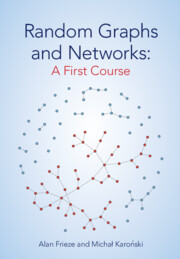Book contents
- Frontmatter
- Dedication
- Contents
- Preface
- Acknowledgments
- Conventions/Notations
- Part I Preliminaries
- Part II Erdős–Rényi–Gilbert Model
- 3 Uniform and Binomial Random Graphs
- 4 Evolution
- 5 Vertex Degrees
- 6 Connectivity
- 7 Small Subgraphs
- 8 Large Subgraphs
- 9 Extreme Characteristics
- Part III Modeling Complex Networks
- References
- Author Index
- Subject Index
5 - Vertex Degrees
from Part II - Erdős–Rényi–Gilbert Model
Published online by Cambridge University Press: 02 March 2023
- Frontmatter
- Dedication
- Contents
- Preface
- Acknowledgments
- Conventions/Notations
- Part I Preliminaries
- Part II Erdős–Rényi–Gilbert Model
- 3 Uniform and Binomial Random Graphs
- 4 Evolution
- 5 Vertex Degrees
- 6 Connectivity
- 7 Small Subgraphs
- 8 Large Subgraphs
- 9 Extreme Characteristics
- Part III Modeling Complex Networks
- References
- Author Index
- Subject Index
Summary
In this chapter, we study some typical properties of the degree sequence of a random graph. We begin by discussing the typical degrees in a sparse random graph, i.e., one with cn/2 edges for some positive constant c. We prove some results on the asymptotic distribution of degrees. We continue by looking at the typical values of the minimum and maximum degrees in dense random graphs, i.e., when edge probability p is constant. Given these properties of the degree sequence of dense graphs, we can then describe a simple canonical labeling algorithm that enables one to solve the graph isomorphism problem on a dense random graph.
Information
- Type
- Chapter
- Information
- Random Graphs and Networks: A First Course , pp. 64 - 77Publisher: Cambridge University PressPrint publication year: 2023
